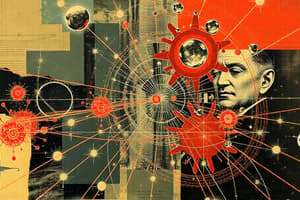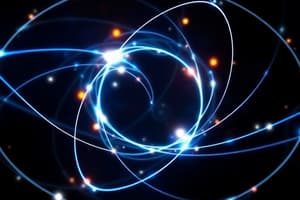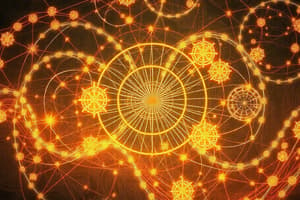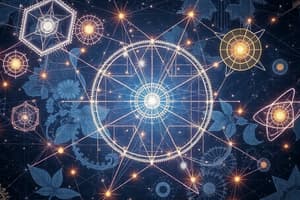Podcast
Questions and Answers
What is the most significant contribution of Feynman diagrams to the field of physics?
What is the most significant contribution of Feynman diagrams to the field of physics?
- Providing a visual method accessible to the general public for understanding quantum mechanics.
- Replacing traditional mathematical models with graphical representations that offer more precise results.
- Establishing a new standard for theoretical physics by disproving previous models of quantum electrodynamics.
- Simplifying complex equations and illustrating particle interactions across time and space, which aids in calculating event outcomes in particle accelerators. (correct)
How did Feynman's work influence the development of theories related to fundamental forces beyond Quantum Electrodynamics (QED)?
How did Feynman's work influence the development of theories related to fundamental forces beyond Quantum Electrodynamics (QED)?
- It had no influence; QED remains the only theory successfully modeled using his diagrams.
- Quantum computing.
- His approaches were directly translated into unifying gravity with the other fundamental forces.
- Feynman's successful methodologies in QED were adapted as a blueprint for modeling theories of other basic forces, such as the nuclear force. (correct)
In what way did Feynman's approach to physics reflect his talent for communicating complex ideas?
In what way did Feynman's approach to physics reflect his talent for communicating complex ideas?
- He used intuitive graphics and real-world demonstrations to explain complicated theories, making them more accessible. (correct)
- He dismissed previous theories and communicated new theories.
- He developed mathematical models that were so abstract they required no physical interpretation.
- He focused exclusively on theoretical constructs, avoiding practical applications to keep the concepts pure.
What was the primary significance of Gell-Mann's quark model introduced in 1964?
What was the primary significance of Gell-Mann's quark model introduced in 1964?
Which aspect of Feynman's diagrams was considered peculiar regarding the quantum universe?
Which aspect of Feynman's diagrams was considered peculiar regarding the quantum universe?
Which aspect of Richard Feynman's early life most directly foreshadowed his later contributions to physics?
Which aspect of Richard Feynman's early life most directly foreshadowed his later contributions to physics?
What was the primary reason Richard Feynman chose to participate in the Manhattan Project during World War II?
What was the primary reason Richard Feynman chose to participate in the Manhattan Project during World War II?
What fundamental problem did Richard Feynman address within the field of Quantum Electrodynamics (QED)?
What fundamental problem did Richard Feynman address within the field of Quantum Electrodynamics (QED)?
What does Feynman's statement, “I think I can safely say that nobody understands quantum mechanics,” suggest about the nature of quantum mechanics itself?
What does Feynman's statement, “I think I can safely say that nobody understands quantum mechanics,” suggest about the nature of quantum mechanics itself?
Beyond his research, in what way did Richard Feynman significantly impact the field of physics?
Beyond his research, in what way did Richard Feynman significantly impact the field of physics?
Flashcards
Who was Richard Feynman?
Who was Richard Feynman?
A physicist known for making quantum theory accessible.
What was the Manhattan Project?
What was the Manhattan Project?
A program during WWII to develop nuclear weapons.
What is Quantum Electrodynamics (QED)?
What is Quantum Electrodynamics (QED)?
Describes interactions of charged particles via photon exchange.
What are Photons?
What are Photons?
Signup and view all the flashcards
What is Caltech?
What is Caltech?
Signup and view all the flashcards
Feynman Diagrams
Feynman Diagrams
Signup and view all the flashcards
Lines in Feynman Diagrams
Lines in Feynman Diagrams
Signup and view all the flashcards
Quantum Electrodynamics (QED)
Quantum Electrodynamics (QED)
Signup and view all the flashcards
Partons
Partons
Signup and view all the flashcards
Quarks
Quarks
Signup and view all the flashcards
Study Notes
- Richard Feynman: Physicist and teacher who made quantum theory engaging.
Early Life and Education
- Born to Lithuanian Jewish parents in New York.
- Did not speak until age 3, but showed talent for math and gadgets.
- Experimented with mathematical theories in high school.
- Rejected by Columbia University.
- Attended MIT, studying mathematics and then physics.
- Achieved a perfect score on Princeton's physics graduate entrance exam in 1939.
- Earned a Ph.D. in quantum mechanics in 1942.
Wartime Work
- Joined the Manhattan Project in 1943 due to concerns about a potential Nazi victory.
- Feynman was made group leader in the theoretical division at Los Alamos aged 24
Career
- Became professor of theoretical physics at Cornell University in 1945.
- In 1950, became professor of theoretical physics at Caltech.
Quantum Electrodynamics (QED)
- Worked on QED, a theory describing interactions of electromagnetically charged particles through photon exchange.
- Improved QED theory using Feynman diagrams in 1948.
- Feynman diagrams illustrate electrons and photons moving in time and space.
- Diagrams represent complex equations and are used in particle accelerators.
- QED became a successful theory and a model for theories of basic forces.
Feynman Diagrams
- Electrons are depicted by straight lines.
- Photon exchange is shown by wavy lines.
- Particles can move forward and backward in time.
- Diagrams are a mathematical model for calculating probabilities of events.
Other Contributions
- Proposed the theory of "partons," which was a precursor to quarks.
- Helped introduce nanotechnology.
- Theorized about quantum computing.
- Explained superfluidity in helium when cooled to absolute zero.
Challenger Disaster
- Investigated the Challenger disaster in 1986.
- Demonstrated the cause of the accident using icy water and rubber.
Recognition
- Received the Albert Einstein Award in 1954.
- Published the Feynman Lectures on Physics in 1964.
- Awarded the Nobel Prize.
Murray Gell-Mann
- Gell-Mann (1929–) proposed a model for classifying subatomic particles in 1964.
- Distinguished between fermions (matter building blocks) and bosons (force carriers).
- Invented the concept of the "quark," a fundamental unit that forms hadrons.
- The quark was isolated using a particle accelerator which verified the model.
- Won the Nobel Prize in Physics in 1969.
- His model became known as the "standard model."
- Accurately described particle interactions to 15 decimal places
Studying That Suits You
Use AI to generate personalized quizzes and flashcards to suit your learning preferences.





